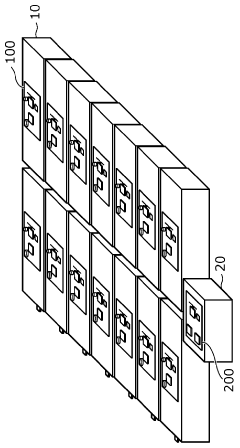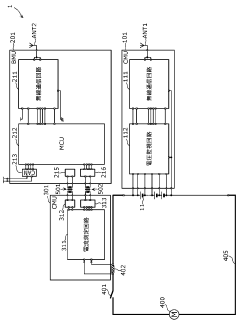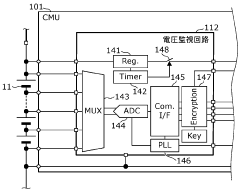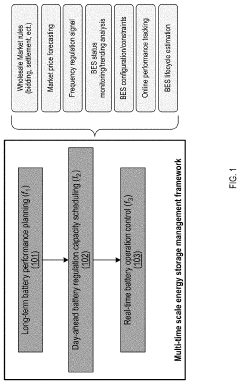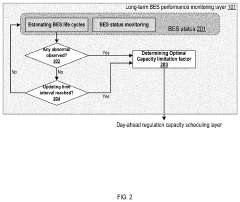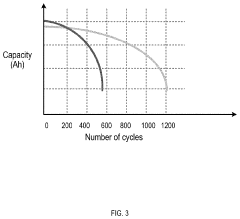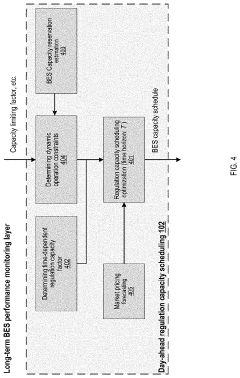Open-Source Battery Management Systems: Opportunities and Challenges
AUG 8, 20259 MIN READ
Generate Your Research Report Instantly with AI Agent
Patsnap Eureka helps you evaluate technical feasibility & market potential.
BMS Evolution and Goals
Battery Management Systems (BMS) have undergone significant evolution since their inception, driven by the rapid advancement of battery technologies and the increasing demands of various applications. Initially, BMS were simple analog circuits designed to monitor basic parameters such as voltage and temperature. As battery technologies progressed, particularly with the rise of lithium-ion batteries, BMS evolved to incorporate more sophisticated digital control systems.
The primary goals of modern BMS have expanded to encompass a wide range of functions. These include accurate state estimation (State of Charge, State of Health, and State of Power), cell balancing, thermal management, and safety monitoring. The evolution of BMS has been closely tied to the development of electric vehicles (EVs), where the need for high-performance, reliable, and safe battery systems has been a driving force.
In recent years, the trend towards open-source BMS has gained momentum, presenting both opportunities and challenges. Open-source BMS aim to provide transparent, customizable, and cost-effective solutions for battery management. This approach allows for greater collaboration among researchers, engineers, and hobbyists, potentially accelerating innovation in the field.
The goals of open-source BMS development include improving accessibility to advanced battery management technologies, fostering a community-driven approach to problem-solving, and enabling rapid adaptation to new battery chemistries and applications. By making BMS designs and software openly available, developers seek to reduce barriers to entry for new players in the battery industry and promote standardization of BMS protocols.
However, the evolution of open-source BMS also faces significant challenges. Ensuring the reliability and safety of these systems is paramount, particularly in critical applications such as EVs. Validating the performance and security of open-source BMS requires rigorous testing and certification processes, which can be resource-intensive.
Looking ahead, the goals for future BMS development, including open-source initiatives, focus on enhancing predictive capabilities through advanced algorithms and machine learning techniques. Improving the accuracy of battery life prediction, optimizing charging strategies, and developing more robust fault detection mechanisms are key objectives. Additionally, there is a push towards creating more modular and scalable BMS architectures that can easily adapt to different battery configurations and applications.
The integration of BMS with broader energy management systems and smart grids represents another important goal. This integration aims to optimize energy usage at both the individual device level and across entire power networks, contributing to more efficient and sustainable energy ecosystems.
The primary goals of modern BMS have expanded to encompass a wide range of functions. These include accurate state estimation (State of Charge, State of Health, and State of Power), cell balancing, thermal management, and safety monitoring. The evolution of BMS has been closely tied to the development of electric vehicles (EVs), where the need for high-performance, reliable, and safe battery systems has been a driving force.
In recent years, the trend towards open-source BMS has gained momentum, presenting both opportunities and challenges. Open-source BMS aim to provide transparent, customizable, and cost-effective solutions for battery management. This approach allows for greater collaboration among researchers, engineers, and hobbyists, potentially accelerating innovation in the field.
The goals of open-source BMS development include improving accessibility to advanced battery management technologies, fostering a community-driven approach to problem-solving, and enabling rapid adaptation to new battery chemistries and applications. By making BMS designs and software openly available, developers seek to reduce barriers to entry for new players in the battery industry and promote standardization of BMS protocols.
However, the evolution of open-source BMS also faces significant challenges. Ensuring the reliability and safety of these systems is paramount, particularly in critical applications such as EVs. Validating the performance and security of open-source BMS requires rigorous testing and certification processes, which can be resource-intensive.
Looking ahead, the goals for future BMS development, including open-source initiatives, focus on enhancing predictive capabilities through advanced algorithms and machine learning techniques. Improving the accuracy of battery life prediction, optimizing charging strategies, and developing more robust fault detection mechanisms are key objectives. Additionally, there is a push towards creating more modular and scalable BMS architectures that can easily adapt to different battery configurations and applications.
The integration of BMS with broader energy management systems and smart grids represents another important goal. This integration aims to optimize energy usage at both the individual device level and across entire power networks, contributing to more efficient and sustainable energy ecosystems.
Market Demand Analysis
The market demand for open-source Battery Management Systems (BMS) has been steadily increasing in recent years, driven by the rapid growth of the electric vehicle (EV) and renewable energy storage sectors. As these industries expand, there is a growing need for cost-effective, flexible, and customizable BMS solutions that can be easily integrated into various applications.
The global BMS market is experiencing significant growth, with projections indicating continued expansion in the coming years. This growth is primarily fueled by the increasing adoption of electric vehicles, the rising demand for renewable energy storage systems, and the growing emphasis on energy efficiency across various industries. The open-source BMS segment, while still a relatively small portion of the overall market, is gaining traction due to its potential to address several key market needs.
One of the primary drivers for open-source BMS demand is the desire for greater flexibility and customization. Traditional proprietary BMS solutions often come with limitations in terms of adaptability and integration with different battery chemistries or system architectures. Open-source BMS offers the potential for manufacturers and developers to tailor the system to their specific requirements, potentially reducing costs and improving overall system performance.
Cost reduction is another significant factor driving interest in open-source BMS. As the EV and energy storage markets continue to mature, there is increasing pressure to reduce the overall cost of battery systems. Open-source solutions can potentially lower development and implementation costs by leveraging community-driven innovation and reducing reliance on proprietary technologies.
The demand for improved interoperability and standardization in the BMS market is also contributing to the growing interest in open-source solutions. As the industry evolves, there is a need for more standardized approaches to battery management, which can facilitate easier integration and compatibility between different systems and components. Open-source BMS has the potential to promote greater standardization and interoperability across the industry.
However, it is important to note that the adoption of open-source BMS faces several challenges. These include concerns about reliability, safety, and regulatory compliance, which are critical factors in battery management applications. Additionally, the need for specialized expertise to implement and maintain open-source solutions may limit their adoption in some market segments.
Despite these challenges, the market trend indicates a growing interest in open-source BMS solutions, particularly in research and development settings, as well as in niche applications where customization and flexibility are paramount. As the technology matures and addresses key concerns, it is likely that the demand for open-source BMS will continue to grow, potentially disrupting traditional BMS market dynamics and driving innovation in the battery management sector.
The global BMS market is experiencing significant growth, with projections indicating continued expansion in the coming years. This growth is primarily fueled by the increasing adoption of electric vehicles, the rising demand for renewable energy storage systems, and the growing emphasis on energy efficiency across various industries. The open-source BMS segment, while still a relatively small portion of the overall market, is gaining traction due to its potential to address several key market needs.
One of the primary drivers for open-source BMS demand is the desire for greater flexibility and customization. Traditional proprietary BMS solutions often come with limitations in terms of adaptability and integration with different battery chemistries or system architectures. Open-source BMS offers the potential for manufacturers and developers to tailor the system to their specific requirements, potentially reducing costs and improving overall system performance.
Cost reduction is another significant factor driving interest in open-source BMS. As the EV and energy storage markets continue to mature, there is increasing pressure to reduce the overall cost of battery systems. Open-source solutions can potentially lower development and implementation costs by leveraging community-driven innovation and reducing reliance on proprietary technologies.
The demand for improved interoperability and standardization in the BMS market is also contributing to the growing interest in open-source solutions. As the industry evolves, there is a need for more standardized approaches to battery management, which can facilitate easier integration and compatibility between different systems and components. Open-source BMS has the potential to promote greater standardization and interoperability across the industry.
However, it is important to note that the adoption of open-source BMS faces several challenges. These include concerns about reliability, safety, and regulatory compliance, which are critical factors in battery management applications. Additionally, the need for specialized expertise to implement and maintain open-source solutions may limit their adoption in some market segments.
Despite these challenges, the market trend indicates a growing interest in open-source BMS solutions, particularly in research and development settings, as well as in niche applications where customization and flexibility are paramount. As the technology matures and addresses key concerns, it is likely that the demand for open-source BMS will continue to grow, potentially disrupting traditional BMS market dynamics and driving innovation in the battery management sector.
Open-Source BMS Status
Open-source Battery Management Systems (BMS) have gained significant traction in recent years, driven by the growing demand for transparent, customizable, and cost-effective solutions in the energy storage sector. The current status of open-source BMS reflects a dynamic landscape with both promising opportunities and notable challenges.
In terms of technological maturity, open-source BMS projects have made substantial progress. Several well-established platforms, such as LibreBMS and OpenBMS, offer comprehensive functionalities including cell voltage monitoring, temperature sensing, and state-of-charge estimation. These projects have demonstrated the feasibility of open-source approaches in achieving reliable battery management, often matching or even surpassing the performance of some proprietary systems.
The community engagement surrounding open-source BMS is robust and growing. Online repositories and forums dedicated to BMS development have seen increased activity, with contributors ranging from hobbyists to academic researchers and industry professionals. This collaborative ecosystem has fostered rapid innovation and knowledge sharing, accelerating the overall development pace of open-source BMS solutions.
However, the adoption of open-source BMS in commercial applications remains limited. While these systems have found success in niche markets and DIY projects, mainstream industrial adoption faces hurdles. Concerns about liability, certification, and long-term support continue to be significant barriers for many potential users, particularly in safety-critical applications like electric vehicles.
Standardization efforts within the open-source BMS community are ongoing but still in early stages. The lack of unified standards for hardware interfaces, communication protocols, and software architectures can lead to compatibility issues and fragmentation within the ecosystem. This challenge is gradually being addressed through initiatives aimed at establishing common frameworks and best practices.
From a technical perspective, open-source BMS projects have made strides in key areas such as cell balancing algorithms, thermal management strategies, and state-of-health estimation. However, gaps remain in advanced features like predictive maintenance and adaptive control systems, which are increasingly important for optimizing battery performance and longevity.
The hardware landscape for open-source BMS is evolving, with a growing number of compatible sensors, microcontrollers, and power management ICs becoming available. This trend is reducing barriers to entry for new developers and facilitating more sophisticated BMS designs. Nevertheless, access to high-quality, cost-effective components remains a challenge, particularly for small-scale projects.
In conclusion, the current status of open-source BMS is characterized by significant technical progress and a vibrant community, balanced against challenges in widespread commercial adoption and standardization. As the field continues to mature, addressing these challenges will be crucial for realizing the full potential of open-source approaches in battery management systems.
In terms of technological maturity, open-source BMS projects have made substantial progress. Several well-established platforms, such as LibreBMS and OpenBMS, offer comprehensive functionalities including cell voltage monitoring, temperature sensing, and state-of-charge estimation. These projects have demonstrated the feasibility of open-source approaches in achieving reliable battery management, often matching or even surpassing the performance of some proprietary systems.
The community engagement surrounding open-source BMS is robust and growing. Online repositories and forums dedicated to BMS development have seen increased activity, with contributors ranging from hobbyists to academic researchers and industry professionals. This collaborative ecosystem has fostered rapid innovation and knowledge sharing, accelerating the overall development pace of open-source BMS solutions.
However, the adoption of open-source BMS in commercial applications remains limited. While these systems have found success in niche markets and DIY projects, mainstream industrial adoption faces hurdles. Concerns about liability, certification, and long-term support continue to be significant barriers for many potential users, particularly in safety-critical applications like electric vehicles.
Standardization efforts within the open-source BMS community are ongoing but still in early stages. The lack of unified standards for hardware interfaces, communication protocols, and software architectures can lead to compatibility issues and fragmentation within the ecosystem. This challenge is gradually being addressed through initiatives aimed at establishing common frameworks and best practices.
From a technical perspective, open-source BMS projects have made strides in key areas such as cell balancing algorithms, thermal management strategies, and state-of-health estimation. However, gaps remain in advanced features like predictive maintenance and adaptive control systems, which are increasingly important for optimizing battery performance and longevity.
The hardware landscape for open-source BMS is evolving, with a growing number of compatible sensors, microcontrollers, and power management ICs becoming available. This trend is reducing barriers to entry for new developers and facilitating more sophisticated BMS designs. Nevertheless, access to high-quality, cost-effective components remains a challenge, particularly for small-scale projects.
In conclusion, the current status of open-source BMS is characterized by significant technical progress and a vibrant community, balanced against challenges in widespread commercial adoption and standardization. As the field continues to mature, addressing these challenges will be crucial for realizing the full potential of open-source approaches in battery management systems.
Current OS BMS Solutions
01 Battery monitoring and control systems
These systems monitor various parameters of battery cells or packs, such as voltage, current, temperature, and state of charge. They use this data to optimize battery performance, ensure safe operation, and extend battery life through intelligent charging and discharging strategies.- Battery monitoring and control systems: These systems monitor various parameters of batteries, such as voltage, current, temperature, and state of charge. They use this information to optimize battery performance, extend battery life, and ensure safe operation. Advanced algorithms are employed to estimate battery health and predict remaining useful life.
- Thermal management in battery systems: Thermal management is crucial for battery performance and safety. These systems regulate battery temperature through cooling or heating mechanisms, preventing overheating and maintaining optimal operating conditions. They may include liquid cooling systems, air cooling, or phase change materials for efficient heat dissipation.
- Cell balancing techniques: Cell balancing ensures that all cells in a battery pack maintain similar voltage levels, preventing overcharging or undercharging of individual cells. This can be achieved through passive or active balancing methods, improving overall battery pack performance and longevity.
- State of charge and state of health estimation: Advanced algorithms and sensors are used to accurately estimate the state of charge (SoC) and state of health (SoH) of batteries. These estimations are crucial for optimizing battery usage, predicting remaining range in electric vehicles, and scheduling maintenance or replacement of battery packs.
- Safety features and fault detection: Battery management systems incorporate various safety features to detect and prevent potential hazards such as overcharging, over-discharging, short circuits, and thermal runaway. These systems can isolate faulty cells, cut off power in emergencies, and provide early warnings for potential issues.
02 Thermal management in battery systems
Thermal management solutions are crucial for maintaining optimal battery temperature during operation. These systems may include cooling or heating mechanisms to prevent overheating or extreme cold, which can affect battery performance and lifespan.Expand Specific Solutions03 Battery state estimation techniques
Advanced algorithms and methods are used to estimate important battery states such as state of charge (SOC), state of health (SOH), and remaining useful life (RUL). These estimations help in optimizing battery usage and predicting maintenance needs.Expand Specific Solutions04 Cell balancing in multi-cell battery packs
Cell balancing techniques are employed to ensure uniform charge distribution across all cells in a battery pack. This helps to maximize overall pack capacity, improve performance, and extend the lifespan of the entire battery system.Expand Specific Solutions05 Integration with energy management systems
Battery management systems are often integrated with broader energy management systems in applications such as electric vehicles or renewable energy storage. This integration allows for optimized energy flow, improved efficiency, and better overall system performance.Expand Specific Solutions
Key BMS Players
The open-source Battery Management Systems (BMS) market is in its early growth stage, characterized by increasing adoption and technological advancements. The global BMS market size is projected to expand significantly, driven by the rising demand for electric vehicles and renewable energy storage solutions. While the technology is maturing, there's still room for innovation and improvement. Key players like Contemporary Amperex Technology, Samsung SDI, and LG Chem are leading the charge in BMS development, with emerging companies such as Brill Power and BattGenie bringing fresh perspectives to the field. The open-source nature of these systems is fostering collaboration and accelerating progress, but challenges remain in standardization and integration across different battery technologies and applications.
Contemporary Amperex Technology Co., Ltd.
Technical Solution: CATL has developed an open-source Battery Management System (BMS) platform that leverages advanced algorithms and machine learning techniques. Their system utilizes a modular architecture, allowing for easy customization and integration with various battery chemistries and configurations. The BMS employs real-time monitoring and predictive analytics to optimize battery performance, extend lifespan, and enhance safety. CATL's open-source approach encourages collaboration and innovation within the industry, potentially accelerating advancements in BMS technology[1][3]. The system incorporates advanced thermal management strategies and state-of-health estimation algorithms, enabling more accurate predictions of battery degradation and remaining useful life[5].
Strengths: Industry-leading expertise in battery technology, extensive R&D resources, and a large market share. Weaknesses: Potential loss of competitive advantage by open-sourcing proprietary technology, and challenges in maintaining quality control across diverse implementations.
Brill Power Ltd.
Technical Solution: Brill Power has developed an innovative open-source BMS that focuses on cell-level control and balancing. Their system employs a distributed architecture, with intelligent modules monitoring and managing individual cells or small groups of cells. This approach allows for more granular control and optimization of battery pack performance. Brill Power's BMS utilizes advanced algorithms to dynamically adjust charging and discharging patterns, maximizing energy efficiency and extending battery life. The open-source nature of their system encourages community-driven improvements and adaptations for various applications, from grid storage to electric vehicles[2][4]. Their BMS also incorporates machine learning techniques to continuously refine its performance predictions and adapt to changing battery conditions over time[6].
Strengths: Highly innovative approach to cell-level management, potential for rapid improvement through community contributions. Weaknesses: Relatively new player in the market, may face challenges in scaling and industry adoption.
Core OS BMS Innovations
Battery management system
PatentWO2023210655A1
Innovation
- The battery management system incorporates a management circuit and monitoring circuits with a wireless communication circuit and timer circuit, allowing the system to intermittently transition between power-on and power-off states, reducing power consumption by only supplying power when necessary, and utilizing external power sources for communication functions.
Multi-time scale energy storage management framework for performance-based frequency regulation (FR) market
PatentActiveUS20200403403A1
Innovation
- A multi-time scale battery energy management framework that decomposes operations into long-term performance monitoring, day-ahead regulation capacity scheduling, and real-time control layers, using data-driven methods to optimize battery usage, monitor degradation, and adjust operations dynamically based on market signals and battery status.
Safety and Standards
Safety and standards play a crucial role in the development and implementation of open-source Battery Management Systems (BMS). As these systems become more prevalent in various applications, ensuring their safety and compliance with established standards is paramount.
One of the primary challenges in open-source BMS is maintaining consistent safety standards across different implementations. Unlike proprietary systems, which are developed and tested by a single entity, open-source BMS can be modified and deployed by various users. This diversity can lead to potential safety risks if not properly managed.
To address these concerns, several international standards have been developed specifically for BMS. These include ISO 26262 for functional safety in automotive applications, IEC 61508 for industrial systems, and UL 1973 for stationary energy storage systems. These standards provide guidelines for design, testing, and validation processes to ensure the reliability and safety of BMS.
Compliance with these standards often requires rigorous testing and documentation. For open-source BMS, this presents both a challenge and an opportunity. While individual implementers may struggle to meet all requirements, the collaborative nature of open-source projects can facilitate shared testing methodologies and results, potentially reducing the burden on individual users.
Another critical aspect of safety in open-source BMS is cybersecurity. As these systems often interface with critical infrastructure or high-value assets, they can be attractive targets for cyberattacks. Implementing robust security measures, such as encryption, authentication protocols, and regular security audits, is essential to protect against potential vulnerabilities.
The open-source community has responded to these challenges by developing tools and frameworks specifically designed to enhance BMS safety. These include software libraries for implementing safety-critical functions, simulation environments for testing BMS behavior under various conditions, and documentation templates to assist with regulatory compliance.
Looking ahead, the continued evolution of safety standards and best practices for open-source BMS will be crucial. As new technologies emerge and applications expand, standards bodies and the open-source community must work together to ensure that safety remains a top priority. This collaboration could lead to the development of more flexible, adaptable standards that can keep pace with rapid technological advancements while maintaining rigorous safety requirements.
One of the primary challenges in open-source BMS is maintaining consistent safety standards across different implementations. Unlike proprietary systems, which are developed and tested by a single entity, open-source BMS can be modified and deployed by various users. This diversity can lead to potential safety risks if not properly managed.
To address these concerns, several international standards have been developed specifically for BMS. These include ISO 26262 for functional safety in automotive applications, IEC 61508 for industrial systems, and UL 1973 for stationary energy storage systems. These standards provide guidelines for design, testing, and validation processes to ensure the reliability and safety of BMS.
Compliance with these standards often requires rigorous testing and documentation. For open-source BMS, this presents both a challenge and an opportunity. While individual implementers may struggle to meet all requirements, the collaborative nature of open-source projects can facilitate shared testing methodologies and results, potentially reducing the burden on individual users.
Another critical aspect of safety in open-source BMS is cybersecurity. As these systems often interface with critical infrastructure or high-value assets, they can be attractive targets for cyberattacks. Implementing robust security measures, such as encryption, authentication protocols, and regular security audits, is essential to protect against potential vulnerabilities.
The open-source community has responded to these challenges by developing tools and frameworks specifically designed to enhance BMS safety. These include software libraries for implementing safety-critical functions, simulation environments for testing BMS behavior under various conditions, and documentation templates to assist with regulatory compliance.
Looking ahead, the continued evolution of safety standards and best practices for open-source BMS will be crucial. As new technologies emerge and applications expand, standards bodies and the open-source community must work together to ensure that safety remains a top priority. This collaboration could lead to the development of more flexible, adaptable standards that can keep pace with rapid technological advancements while maintaining rigorous safety requirements.
Ecosystem Development
The development of an ecosystem around open-source Battery Management Systems (BMS) is crucial for their widespread adoption and continuous improvement. This ecosystem encompasses various stakeholders, including developers, manufacturers, researchers, and end-users, who collaborate to enhance the functionality, reliability, and accessibility of open-source BMS solutions.
One of the primary drivers of ecosystem development is the establishment of open-source communities. These communities serve as platforms for knowledge sharing, code contribution, and collaborative problem-solving. Platforms like GitHub and GitLab host numerous open-source BMS projects, allowing developers to contribute code, report issues, and suggest improvements. This collaborative approach accelerates innovation and helps identify and address potential vulnerabilities in BMS designs.
Educational institutions play a vital role in nurturing the open-source BMS ecosystem. Universities and research centers are increasingly incorporating open-source BMS projects into their curricula and research programs. This not only trains the next generation of BMS developers but also contributes to the advancement of BMS technology through academic research and publications.
Industry partnerships are another critical aspect of ecosystem development. Collaborations between open-source BMS developers and battery manufacturers, electric vehicle companies, and renewable energy firms can lead to the creation of more robust and application-specific BMS solutions. These partnerships also provide valuable real-world testing environments for open-source BMS, helping to validate their performance and reliability.
Standardization efforts are essential for promoting interoperability and wider adoption of open-source BMS. Organizations like the Linux Foundation's LF Energy project are working towards establishing common standards and protocols for BMS communication and data exchange. This standardization facilitates easier integration of open-source BMS into various applications and encourages more manufacturers to adopt open-source solutions.
The development of supporting tools and resources is crucial for ecosystem growth. This includes the creation of simulation software, testing frameworks, and documentation tools specifically designed for open-source BMS development. These resources lower the entry barrier for new developers and help ensure the quality and reliability of open-source BMS implementations.
Funding and support mechanisms are vital for sustaining the open-source BMS ecosystem. Grants from government agencies, industry sponsorships, and crowdfunding initiatives can provide the necessary resources for ongoing development and maintenance of open-source BMS projects. This financial support is crucial for addressing long-term challenges such as security updates and compatibility with evolving battery technologies.
One of the primary drivers of ecosystem development is the establishment of open-source communities. These communities serve as platforms for knowledge sharing, code contribution, and collaborative problem-solving. Platforms like GitHub and GitLab host numerous open-source BMS projects, allowing developers to contribute code, report issues, and suggest improvements. This collaborative approach accelerates innovation and helps identify and address potential vulnerabilities in BMS designs.
Educational institutions play a vital role in nurturing the open-source BMS ecosystem. Universities and research centers are increasingly incorporating open-source BMS projects into their curricula and research programs. This not only trains the next generation of BMS developers but also contributes to the advancement of BMS technology through academic research and publications.
Industry partnerships are another critical aspect of ecosystem development. Collaborations between open-source BMS developers and battery manufacturers, electric vehicle companies, and renewable energy firms can lead to the creation of more robust and application-specific BMS solutions. These partnerships also provide valuable real-world testing environments for open-source BMS, helping to validate their performance and reliability.
Standardization efforts are essential for promoting interoperability and wider adoption of open-source BMS. Organizations like the Linux Foundation's LF Energy project are working towards establishing common standards and protocols for BMS communication and data exchange. This standardization facilitates easier integration of open-source BMS into various applications and encourages more manufacturers to adopt open-source solutions.
The development of supporting tools and resources is crucial for ecosystem growth. This includes the creation of simulation software, testing frameworks, and documentation tools specifically designed for open-source BMS development. These resources lower the entry barrier for new developers and help ensure the quality and reliability of open-source BMS implementations.
Funding and support mechanisms are vital for sustaining the open-source BMS ecosystem. Grants from government agencies, industry sponsorships, and crowdfunding initiatives can provide the necessary resources for ongoing development and maintenance of open-source BMS projects. This financial support is crucial for addressing long-term challenges such as security updates and compatibility with evolving battery technologies.
Unlock deeper insights with Patsnap Eureka Quick Research — get a full tech report to explore trends and direct your research. Try now!
Generate Your Research Report Instantly with AI Agent
Supercharge your innovation with Patsnap Eureka AI Agent Platform!
